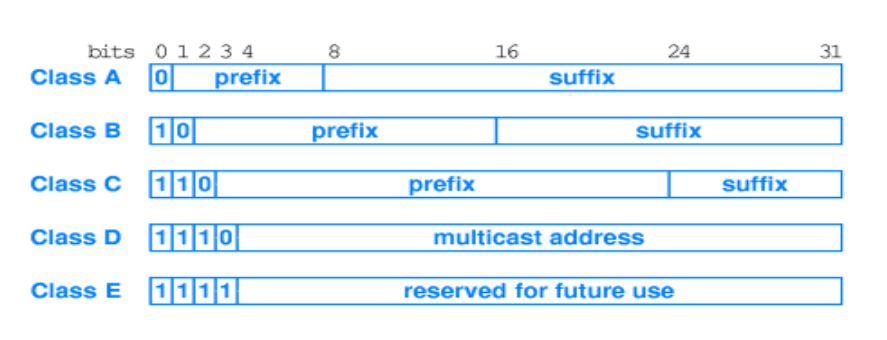2. IP Addressing #
Internet Protocol (IP) #
The Internet Protocol must be able to provide communications between hosts on different types of networks (different data-link implementations).
IP Addresses must include information about what network the receiving host is on to make routing feasible.
IP uses IP addresses to route information between networks, hence every device requires a unique address.
IP Addresses #
IP Addresses are different to the underlying data-link MAC address.
They are independent of hardware addressing and are only understood by software.
They are used by higher-layer protocols and applications.
Each host on the Internet has a unique 32-bit IP address (IPv4). It is divided into two parts:
- The prefix identifies the network (Network ID)
- The suffix identifies the host (Host ID)
Network ID #
Network IDs are assigned to organisations by a global authority:
- American Registry for Internet Numbers (ARIN) for the Americas
- Réseaux IP Européens (RIPE) for Europe, the Middle East, and Asia
- Asia Pacific Network Information Centre (APNIC) for Asia and Oceania
Host ID #
Host IDs are assigned locally by a system administrator and can be configured manually or through DHCP.
Classful IP Addressing #
Classful IP Addressing divides IP address into five groups.
- The initial bits determine the class
- The class determines the boundary between the prefix and suffix
- Three classes are used for networks. Class D and Class E are used for multicast and experimentation respectively.

Larger prefix sizes allow for more networks. The more networks, the less hosts.
- Total IP Addresses: 4 billion:
- Class A: 126 networks, 16M hosts
- Class B: 16K networks, 64K hosts
- Class C: 2M networks, 256 hosts
Class A #
126 networks with up to 16 million hosts.
1.0.0.0 - 127.255.255.255
- Start with binary 0
- All 0 reserved
- 01111111 (127) reserved for loopback
- Range 1.x.x.x to 126.x.x.x
- All allocated
Class B #
16,382 networks with up to 64,000 hosts.
128.0.0.0 - 191.255.255.255
- Start with binary 10
- Range 128.x.x.x to 191.x.x.x
- Second Octet also included in network address
- 214 = 16,384 Class B addresses
- All allocated
Class C #
2 million networks with up to 254 hosts.
192.0.0.0 - 223.255.255.255
- Start with binary 110
- Range 192.x.x.x to 223.x.x.x
- Second and third octet also part of network address
- 221 = 2,097,152 addresses
- Nearly all allocated
Dotted Decimal Notation #
IP Addresses are usually shown in dotted decimal notation.
10000000 10000111 01000100 00000101
128.165.68.5
This allows humans to avoid binary and makes it easier to type IP addresses.
IP Address Assignment #
An IP Address does not identify a specific computer, instead a connection between a computer and network.
A computer with multiple network connections (e.g. a router) must be assigned an IP address for each connection.
Host and Network Addresses #
- A single network interface is assigned a single IP address called the host address
- A host may have multiple interfaces and therefore multiple host addresses
- Hosts that share a network all have the same IP network address (the network ID)
Special Addresses #
- An IP Broadcast Address has a host ID of all 1s
- An IP address that has a host IDs of all 0s is called a network address and refers to an entire network
- Network addresses are not used in packets
- Loopback never leaves local computer
Loopback Address #
Addresses beginning with binary 01111111 or decimal 127 are loopback addresses.
They are reserved for loopback and internal testing on a local machine.
Private IP Addresses #
- Specific ranges of IP addresses set aside for use in private networks (RFC 1918)
- Use is restricted to private internets; routers in public Internet discard packets with these address
- Ranges
- Range 1: 10.0.0.0 to 10.255.255.255
- Range 2: 172.16.0.0 to 172.31.255.255
- Range 3: 192.168.0.0 to 192.168.255.255
- Network Address Translation (NAT) is used to convert between private and global IP addresses.